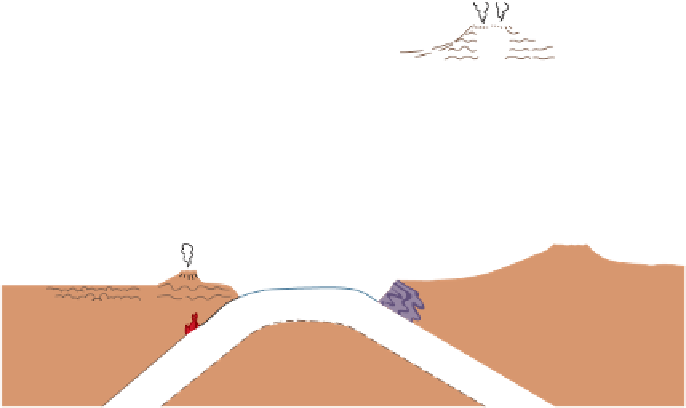Geology Reference
In-Depth Information
such events is simply eroded older con-
tinental crust; however, a significant
amount of new material is added to
continents as well, such as igneous rocks
that formed as a consequence of sub-
duction and partial melting. Although
subduction is the predominant influ-
ence on the tectonic history in many re-
gions of orogenesis, other processes are
also involved in mountain building and
continental accretion, especially the ac-
cretion of terranes.
Geologists now know that portions
of many mountain systems are com-
posed of small accreted lithospheric
blocks that are clearly of foreign ori-
gin. These
terranes
differ completely in
their fossil content, stratigraphy, struc-
tural trends, and paleomagnetic proper-
ties from the rocks of the surrounding
mountain system and adjacent craton.
In fact, these terranes are so different
from adjacent rocks that most geolo-
gists think that they formed elsewhere
and were carried great distances as parts
of other plates until they collided with
other terranes or continents.
Geologic evidence indicates that
more than 25% of the entire Pacific
Coast from Alaska to Baja California
consists of accreted terranes. The accret-
ing terranes are composed of volcanic
island arcs, oceanic ridges, seamounts,
volcanic plateaus, hot-spot tracks, and
small fragments of continents that were
scraped off and accreted to the conti-
nent's margin as the oceanic plate on
which they were carried was subducted
under the continent.
Geologists estimate that more
than 100 different-sized terranes
have been added to the western mar-
gin of North America during the last
200 million years (
◗
Figure 22.9
Mesozoic Tectonic Evolution of the Sierra Nevada Interpretation of the
tectonic evolution of the Sierra Nevada during the Mesozoic Era.
Gap
Sierra Nevada
Paleozoic
sedimentary and
volcanic rocks
1
Late Triassic-Early Jurassic
160-200 km
White
Mountains
Back-arc
basin?
Embryonic
island arc
Mélange
2
Middle Jurassic
200-240 km
Interarc
basin
North-central
Nevada
Great Valley
ophiolite
Remnant
arc
Island arc
3
Early Late Jurassic
Mélanges
Melones
fault zone
Bear Mts.
fault zone
Deposition of basal
Knoxville Fm.
Begin
Franciscan
subduction
Former island arc
Blueschist in Franciscan Complex
150 m.y.a
4
Late Jurassic-Nevadan orogeny
80-120 km
Post-Nevadan
plutons
Great Valley
ophiolite
Figure 22.18). The
Wrangellian terranes (Figure 22.1b) are
a good example of terranes that have
been accreted to North America's west-
ern margin.
The basic plate tectonic recon-
struction of orogenies and continental
accretion remains unchanged; however, the details of such
reconstructions are decidedly different in view of terrane
tectonics. For example, growth along active continental mar-
gins is faster than along passive continental margins because
of the accretion of terranes. Furthermore, these accreted ter-
ranes are often new additions to a continent rather than re-
worked older continental material.
◗
5
Latest Jurassic
WHAT ROLE DID ACCRETION OF
OF WESTERN NORTH AMERICA?
In the preceding sections, we have discussed orogenies along
convergent plate boundaries resulting in continental accre-
tion. Much of the material accreted to continents during




















Search WWH ::

Custom Search